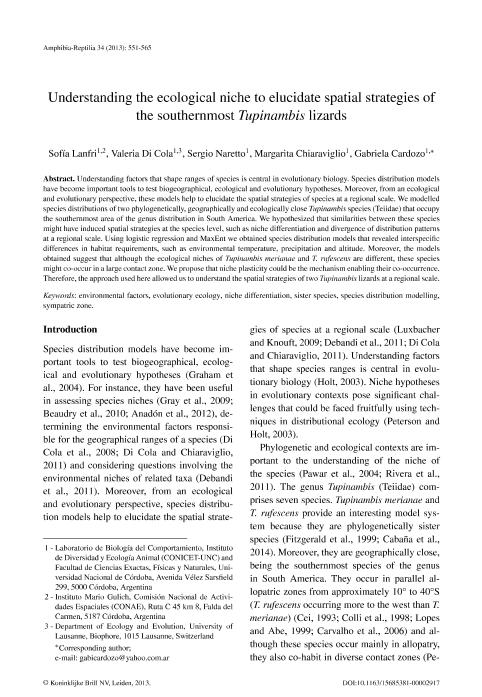Artículo
Understanding the ecological niche to elucidate spatial strategies of the the southernmost Tupinambis
Lanfri, Sofía; Di Cola Bucciarelli, Valeria ; Naretto, Sergio
; Naretto, Sergio ; Chiaraviglio, Margarita; Cardozo Milanesio, Gabriela Alejandra
; Chiaraviglio, Margarita; Cardozo Milanesio, Gabriela Alejandra
 ; Naretto, Sergio
; Naretto, Sergio ; Chiaraviglio, Margarita; Cardozo Milanesio, Gabriela Alejandra
; Chiaraviglio, Margarita; Cardozo Milanesio, Gabriela Alejandra
Fecha de publicación:
06/2013
Editorial:
Brill Academic Publishers
Revista:
Amphibia-reptilia
ISSN:
0173-5373
Idioma:
Inglés
Tipo de recurso:
Artículo publicado
Clasificación temática:
Resumen
Understanding factors that shape ranges of species is central in evolutionary biology. Species distribution models have become important tools to test biogeographical, ecological and evolutionary hypotheses. Moreover, from an ecological and evolutionary perspective, these models help to elucidate the spatial strategies of species at a regional scale. We modelled species distributions of two phylogenetically, geographically and ecologically close Tupinambis species (Teiidae) that occupy the southernmost area of the genus distribution in South America. We hypothesized that similarities between these species might have induced spatial strategies at the species level, such as niche differentiation and divergence of distribution patterns at a regional scale. Using logistic regression and MaxEnt we obtained species distribution models that revealed interspecific differences in habitat requirements, such as environmental temperature, precipitation and altitude. Moreover, the models obtained suggest that although the ecological niches of Tupinambis merianae and T. rufescens are different, these species might co-occur in a large contact zone. We propose that niche plasticity could be the mechanism enabling their co-occurrence. Therefore, the approach used here allowed us to understand the spatial strategies of two Tupinambis lizards at a regional scale.
Palabras clave:
Tupinambis
,
Niche
,
Distribution Models
Archivos asociados
Licencia
Identificadores
Colecciones
Articulos(IDEA)
Articulos de INSTITUTO DE DIVERSIDAD Y ECOLOGIA ANIMAL
Articulos de INSTITUTO DE DIVERSIDAD Y ECOLOGIA ANIMAL
Citación
Lanfri, Sofía; Di Cola Bucciarelli, Valeria; Naretto, Sergio; Chiaraviglio, Margarita; Cardozo Milanesio, Gabriela Alejandra; Understanding the ecological niche to elucidate spatial strategies of the the southernmost Tupinambis; Brill Academic Publishers; Amphibia-reptilia; 34; 4; 6-2013; 551-565
Compartir



